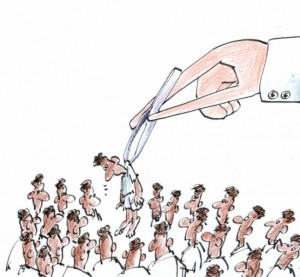 You may have noticed a new feature here that comes out on Sunday mornings.
You may have noticed a new feature here that comes out on Sunday mornings.
Very creatively called, “The Three Things,” Howie Goldfarb, Michael Schechter, and I provide links to one article, video, or podcast we think the other should pay attention to that is outside our professional comfort zones.
A couple of weeks ago, Howie suggested, “Robbie and Ruthie Talk about Pickles” from the Ad Contrarian blog.
If you missed it, I’m going to hope Ad Contrarian author, Bob Hoffman, doesn’t mind my posting it here.
The phone rings
ROBBIE: Hello.
RUTHIE: Robert, it’s your Aunt Ruthie.
ROBBIE: Hi Ruthie.
RUTHIE: Hello, darling.
ROBBIE: What’s up?
RUTHIE: I’m calling to ask a favor.
ROBBIE: Sure.
RUTHIE: My pickles are selling very well, and Big Save says they’ll put them in their supermarkets all across the country, but I have to do some advertising. So I thought as long as my nephew is a big shot advertising man, maybe your company could make an ad for me.
ROBBIE: Sure.
RUTHIE: So here’s what I want the ad to say… Aunt Ruthie’s Pickles are homemade, they taste wonderful, and we use fresh ingredients.
ROBBIE: Well, okay, but we really need to think a little more about this.
RUTHIE: Um…okay…what?
ROBBIE: Well, first we need to understand the consumer.
RUTHIE: The consumer?
ROBBIE: It’s a…a person who buys things.
RUTHIE: Everyone buys things.
ROBBIE: Right…
RUTHIE: So how is a consumer different from a person?
ROBBIE: Um…it’s not.
RUTHIE: So why don’t you just call it a person?
ROBBIE: Okay, so it’s a person.
RUTHIE: Okay so you have to understand this…person. Why?
ROBBIE: So we can know how they use your product.
RUTHIE: They eat it. How else do you use a pickle?
ROBBIE: Well, yeah…but why do they eat it?
RUTHIE: Because it tastes good. (PAUSE) Robbie, are you okay?
ROBBIE: I’m fine. You see, we have to analyze who we should be talking to in our advertising. We call that a target audience. Should we talk to women 18-49 or men 25-34 or…?
RUTHIE: Why don’t we just talk to people who like pickles?
ROBBIE: Well you see, the perception of your brand has to resonate…
RUTHIE: My what?
ROBBIE: Your brand…it’s the personality of your product…
RUTHIE: My pickles have a personality?
ROBBIE: Well, it’s not the pickles that have the personality, it’s you, it’s Aunt Ruthie’s Pickles…
RUTHIE: My personality? I’m a pain in the ass. What the hell does anyone care about my personality?
ROBBIE: But Aunt Ruthie’s is your brand.
RUTHIE: I thought Aunt Ruthie’s was my name.
ROBBIE: And your name is your brand
RUTHIE: So why don’t you just call it my name? (PAUSE) Robert, are you having that problem you had back in college?
ROBBIE: You know I’ve committed to never doing that again…
RUTHIE: So why are you talking like this? Is this how you talk in your company?
ROBBIE: Well, yes. You see, Aunt Ruthie, we believe advertising isn’t really about selling your pickles. It’s about developing a relationship between the consumer and your brand by having integrated communications that create advocates by over-delivering on brand expectations and creating relevant brand conversations…
RUTHIE: You know, honey, your cousin Stanley majored in English, maybe I’ll just ask him to write the ad..
ROBBIE: No, no….I’ll..
RUTHIE: Robbie, darling, you know I love you, right? And I would never say anything to hurt you. But listen to me, darling. You people are crazy.
Click
Customers as People
I have you read this because Jack Dorsey, the co-founder of Twitter and CEO of Square (the company that lets you take credit card payments via your iPhone or iPad), recently wrote a letter to his team about their use of the word “users” to describe customers.
Just like Robbie wants his Aunt Ruthie to do, we tend to think of our customers as users, target audiences, stakeholders, and demographics while forgetting they’re people.
Dorsey tells the story of being in a Square board meeting when new board member, Howard Schultz, asked him why they call their customers users.
He says:
The term “user” made its appearance in computing at the dawn of shared terminals (multiple people sharing time slices of one computing resource). It was solidified in hacker culture as a person who wasn’t technical or creative, someone who just used resources and wasn’t able to make or produce anything (often called a “luser”). And finally, it was made concrete by Internet companies whose business models depended on two discrete classes of usage, a paying customer (often purchasing ads) and a non-paying consumer (subsidized by viewing the ads).
He goes on to say elevating the term to “customer” and away from “user” automatically creates a better environment for customer service because you begin to think of them as human beings and not just a statistic.
He challenges every business owner to do the same.
So, I ask you, how do you describe the people who buy your product or service?
A version of this first appeared in my weekly Crain’s Chicago Business column.
***************************************************************************
This Wednesday, October 24, join Mark Story for a Livefyre Q&A to discuss his book, “Starting Your Career as a Social Media Manager.”
He’ll be live from 12-1 ET so set a reminder and then come hang out in the comments to ask him questions about love, life, and his book.